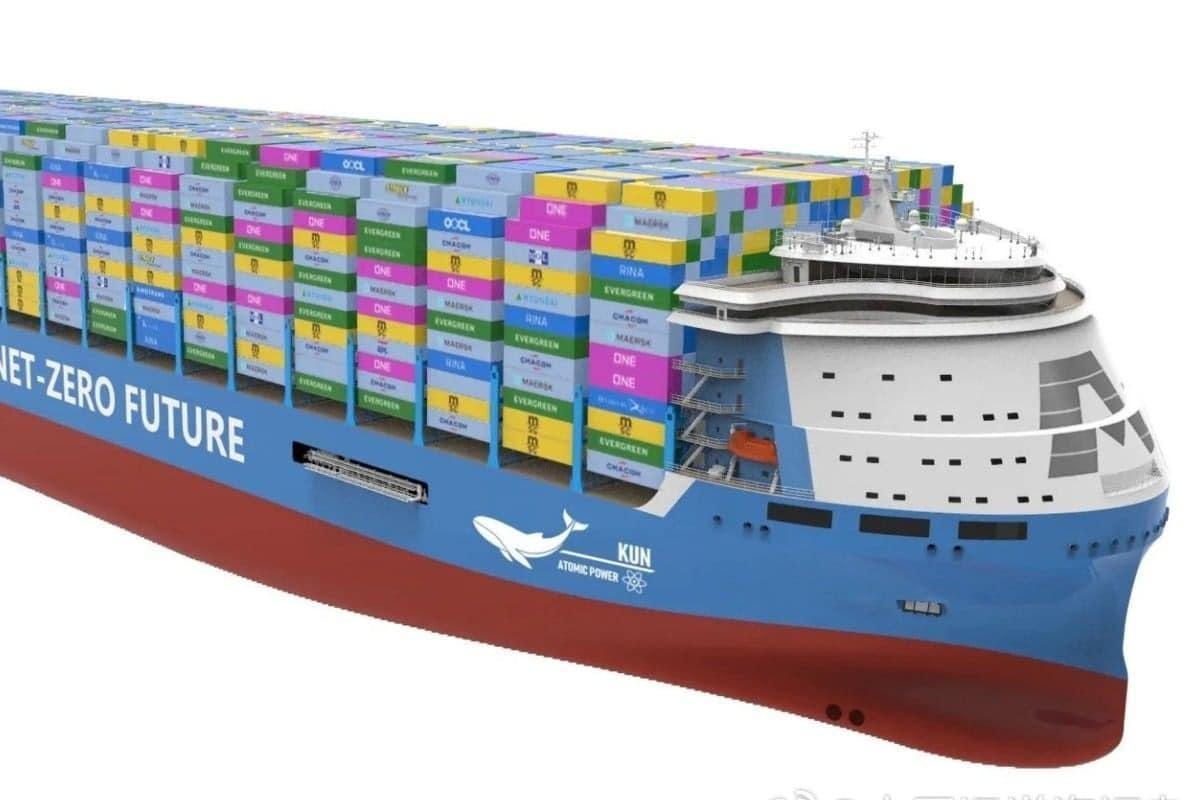Link: https://indiandefencereview.com/china-unveils-worlds-largestnuclear-cargo-ship-built-to-sail-nonstop-for-a-decade-withoutrefueling/
Please see the link above for the source text.

Link: https://indiandefencereview.com/china-unveils-worlds-largestnuclear-cargo-ship-built-to-sail-nonstop-for-a-decade-withoutrefueling/
Please see the link above for the source text.
China just unveiled a game-changing cargo ship powered by a mysterious nuclear technology the West gave up on decades ago. With no need to refuel for years, this silent giant could upend global trade and energy dominance.

Kenza Ould Djoudi November 17, 2025

Cargo Ship Image For Representation Only | Indian Def. Review
China has unveiled a concept for what could become the world’s
most advanced nuclear-powered cargo ship—a 14,000-container vessel powered not by uranium, but by thorium, a radioactive metal long considered a cleaner, safer nuclear alternative. The reactor at its core is a molten salt system operating at a thermal output of 200 megawatts, the same as that used by the U.S. Navy’s Seawolf-class nuclear submarines.
The ship’s propulsion system, revealed in detail earlier this month by Hu Keyi, chief engineer at Jiangnan Shipbuilding Group, reflects a broader strategy to leapfrog Western shipping and energy infrastructure by investing in thorium-based nuclear technologies. These efforts coincide with China’s aggressive pursuit of energy independence and maritime dominance.
The thorium cargo vessel is not just a scientific achievement—it is a strategic signal. If realized, it could drastically reduce the carbon footprint of maritime freight, eliminate the need for regular refueling, and enable long-term, autonomous ocean operations. But the initiative is also fraught with engineering, financial, and political challenges that stretch far beyond the shipyard.
Thorium-Powered and Built for Endurance
The vessel’s 200MW thorium molten salt reactor (TMSR) does not directly drive propulsion. Instead, it powers a supercritical CO (sCO) generator ₂₂ using the Brayton cycle, which converts thermal energy into 50 megawatts of electricity. As outlined by Hu Keyi in several official statements and technical disclosures, the conversion efficiency of this cycle reaches 45–50%, compared to the 33% efficiency typical of conventional steam-based nuclear systems.
This modular reactor operates at atmospheric pressure and requires no water for cooling, eliminating the need for bulky support systems and significantly reducing acoustic and thermal signatures. Its design includes two passive heat removal systems and a fail-safe chamber in which molten salt fuel solidifies if overheated, containing any radioactive material without
human intervention.

The nuclear-powered container ship concept was first revealed by Jiangnan Shipyard in 2023. Now key technical details have been disclosed. Image: Weibo/中国 远洋海运杂志社
The reactor module has a 10-year sealed operational life. After that period, it is removed and replaced rather than refueled on-site —limiting exposure risk and reducing the complexity of maintenance procedures.
The cargo ship builds directly on breakthroughs from China’s landbased thorium molten salt reactor, which became the first in the world to achieve long-term stable operation in 2025, as reported in Interesting Engineering and SCMP. Built in the Gobi Desert, the pilot reactor demonstrated the viability of thorium as a
nuclear fuel, including the successful conversion of thorium into uranium-233—a milestone long sought but never previously achieved at scale.
China’s thorium ambitions are fueled—literally and figuratively—by its large domestic reserves, particularly in Inner Mongolia. These reserves offer long-term supply security, further insulating Beijing from global uranium markets.
In parallel, China is developing additional thorium-based naval systems, including a Suezmax oil tanker powered by a leadbismuth fast reactor and a floating nuclear plant using hightemperature gas-cooled reactors. These programs indicate a longterm effort to establish a thorium-powered maritime ecosystem.
Despite the ambitious technical specifications, the thorium cargo ship remains at concept stage. No construction timeline has been confirmed, and regulatory approval—particularly for civilian ports and international shipping lanes—is a major hurdle.
The ship’s costs are another barrier. As noted by Hu Keyi and summarized by Marine Insight, nuclear-powered vessels are significantly more expensive to build and operate than conventional ones. The lack of insurance frameworks, trained nuclear-qualified crews, and clear international legal structures around liability and decommissioning only compounds the financial risk.
While thorium reactors are less proliferation-prone than uranium-based systems, nuclear shipping of any kind is politically sensitive. The International Maritime Organization (IMO) has yet to adopt a standardized global framework for nuclearpowered commercial vessels, and port state control regimes across Asia, Europe, and North America remain cautious.
Moreover, there is no existing global protocol for the transportation and disposal of thorium reactor modules, raising long-term environmental and safety concerns that remain unresolved.
The idea of thorium-powered shipping isn’t new—it was trialed in the U.S. in the 1960s but ultimately shelved after technical and cost setbacks. Today, China’s thorium vessel may represent the most serious attempt to bring the concept into full-scale deployment. If it succeeds, the implications could be transformative: lower emissions, greater strategic autonomy at sea, and a viable model for safe, compact nuclear energy.
But if the program falters, it will reaffirm long-standing doubts about thorium’s scalability, reliability, and cost-effectiveness. The outcome of this ship—still theoretical—will shape whether thorium remains a niche technology or becomes a cornerstone of maritime and energy innovation.
The real test now is whether China can take a concept proven in the desert and make it seaworthy in every sense: technically, economically, and politically. If that happens, the global maritime order won’t just be disrupted. It could be rewritten.